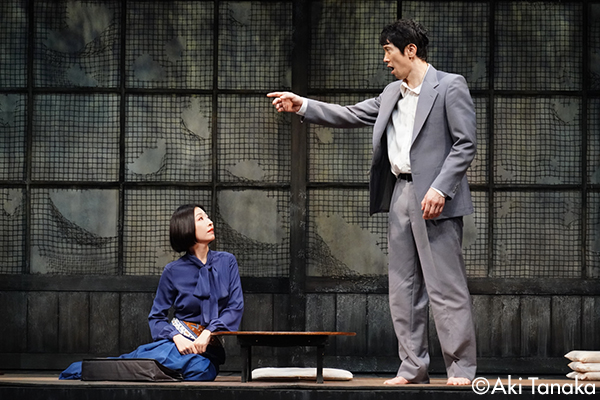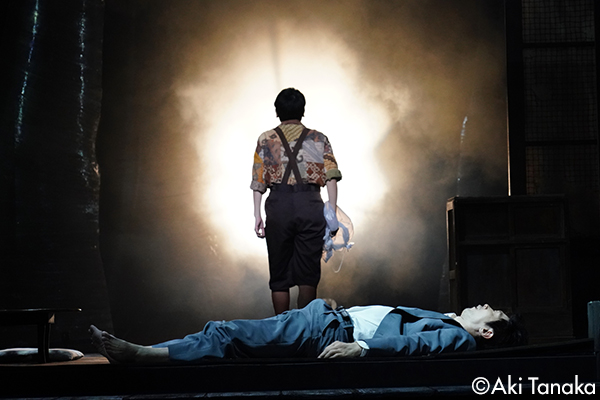——Nezu is wandering in the forest at night with the feeling that something is following him. He flees home, and there he hears the echoing voice of his father saying, “You should have died.”——
Nezu wakes from this recurring nightmare, and at that moment a young couple named Tadashi and Kaname burst into the shack, as if running from something. And with this, a new chain of events that appear to have been frozen in time, are suddenly set in motion.
For the past 20 years, Nezu says he had just been sleeping and waking. When the couple ask for a night’s lodging, Nezu says he’ll hold on to their wallet in lieu of payment. Though his attitude and way of speaking seem arrogant, but for some reason there is still something innocent and harmless about him.
Due to the sharp drop in the birthrate in Japan, the country has adopted a policy of retaining babies and pregnant women at hospitals to ensure their health. Kaname, who is now pregnant, rejects this mandatory hospitalization and has run away with her lover Tadashi. Feeling an affinity with them as a social outcast, Nezu begins to tell them his life story.
Raised in an orphanage, Nezu had a kid named Santa that was like his younger brother. Santa was adopted by the president of a small company, but he died six months later. One day, Nezu found a mysterious circle floating in the air, and when he passed through it he saw the supposedly dead Santa standing there.
Talking with Santa, Nezu learned that he had been treated cruelly. Nezu told the staff at the orphanage about this, but they would listen. The next time he found that mysterious circle and entered it, Nezu found himself playing with the Santa he knew as a child.
After he decided not to pass through the mysterious circle the third time it appeared before him on the morning that he was to take his high school entrance exam, Nezu never found the circle again. After poverty forced him to drop out of high school, Nezu sought revenge by setting fire to the home of that small-company president.
In the intervals between Nezu’s monologue of memories the couple talk about the city they have fled. At the hospital where the children are kept, they never learn to speak. All they say is “fuga-fuga” like babies, and then a monster suddenly appeared, too. Hearing the that Nezu is a half-
yokai
with supernatural powers, Tadashi and Kaname ask him if he knows the cause of the “fuga-fuga disease.”
Why did Nezu become a half-
yokai
in the first place? After he set fire to the president’s house, he lived by pickpocketing and shoplifting, and he also spent time in jail. Eventually he became a con-man. Failing to get by in the city, Nezu came alone to this village and, pretending to be a traveling salesman, he tries to trick an old woman in one of the homes out of her money.
The old woman mistakes Nezu for her dead son Sankichi. When Sankichi’s wife Hanako comes home, she says the same thing, and the two of them make tempura to feed him.
In fact the old woman, called Obaba (grandma), is a fallen local guardian deity, and Hanako is a spirit from Yukiyama (Snow Mountain), and the tempura was “cat soul tempura” that has the power to draw out a person’s soul. After Nezu ate the tempura, he meets his childhood friend Santa again, who was now a spirit wandering in the boundary purgatory between life and death.
Santa begged the grandma to give Nezu back his soul. But he couldn’t be returned fully to a human again, and so he became a half-
yokai
. But Nezu says that he still has his attachment to money, and laughingly he says that as a half-
yokai
he doesn’t have bowel movements anymore but he still farts.
Time shifts between the past and the present, and in the shack, Nezu, grandma, Hanako, and the
yokai
Mamezo are joined by Tadashi and Kaname and the talk turns to what humans have named
yokai
. Nezu begins to reminisce about his life as a half-
yokai
.
If there are no humans to perceive them, deities, spirits and
yokai
can’t exist. Twenty years have passed since Mamezo came to announce that the last of village’s old elders had died. Until Tadashi and Kaname came, Nezu had just been sleeping the time away in this village.
Kaname’s father Yamada, the dishonest mayor of the city, has come looking for his daughter along with her former fiancé, the doctor Nekoyama, and the police chief. Nezu uses a big fart to let the young lovers escape. He tries to get on the good side of the mayor by proposing that he might be able to exterminate a
yokai
if one appeared in his city.
At Nekoyama’s hospital that keeps the children, a mother named Aoko whose infant was taken from her becomes deranged when she finds the baby’s body in the hospital and she is shot and killed when she attacks the mayor. But Aoko comes back to life as a monster and sends out light by drawing in the death of the babies and cats and other things around her.
This monster she has become speaks mysterious words, like “Kokeka kee-kee,” so it comes to be known as the Kokeka monster. It repulses the attacks of the security force sent to destroy it, and it goes on to spread destruction around the city knocking down buildings and by creating giant oversized plants.
Nezu tells the mayor that Kokeka is a deity and that instead of trying to eliminate it he should try to appease it. Nekoyama has chased down Kaname and her lover and brought them back, but now he becomes frightened by a sense of something suspicious in the mountains, and when he opens the sliding partition to look outside, Kokeka is standing there.
Nezu translates Kokeka’s words as it presses toward the mayor and tells him to repent. The mayor tries to flee, but he runs into villagers doing their festival’s dance of offering and his way is blocked by the festival dancers wearing costumes of a mask dance of the southern seas. The moment Kokeka grabs the mayor, the room goes dark.
When the lights come back on, the mayor is in a dazed state and can only babble
fuga-fuga
sound. Nekoyama and the others hurriedly bustle the mayor away and flee. To the grateful Tadashi and Kaname, Nezu laughs and admits that there was no way he could understand the words spoken by Kokeka and had just been making it up.
Suddenly the room gets chilly and out of the dark emerge Hanako and the grandma. Hanako embraces Nezu affectionately. Tadashi and Kaname can’t see Hanako.
“I think I might like to live in this village,” says Kaname. Realizing that suddenly Nezu has also disappeared from their sight, the couple feels as if they are possessed. But, under the tatami mats they find the wallet that Nezu had hidden.
In the shack now are the invisible Nezu, Hanako, Obaba and Mamezo. There is a blend of the sounds of rustling leaves, the chirping of bugs and the rhythm of the festival drums as the lights slowly fade out. In the darkness, we hear Nezu’s words of farewell.







